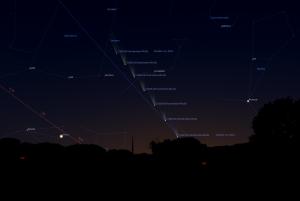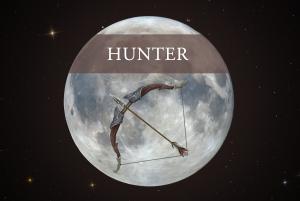Celebration of Space - October 10, 2024

The Aurora Borealis over Ninigret Park, home to Frosty Drew Observatory. Image credit: Frosty Drew Astronomy Team member, Greg Mastrioanni captured this image.
Now that Comet C/2023 A3 Tsuchinshan–ATLAS (A3), has passed perihelion (its closest approach to the Sun), the comet is wrapping up an orbit in between the Earth and Sun, and quickly moving into our evening sky. Here is a video of the last several days showing the comet moving into the LASCO C3 field on the Solar and Heliospheric Observatory. Note the bright star to the left of the Sun in the video is Mercury. Starting on the evening of October 13, 2024, the comet should be quite naked eye visible in the evening sky just after sunset. Each consecutive day after that the comet will rise higher into the evening sky, offering views for longer periods of time and further into twilight. As of today, the comet is as bright as magnitude -3.0, which is close to the brightness of Venus. The comet will continue to dim over the next several weeks, though we may have a great window of viewing. The only problem we are seeing at this point is the Moon. The full lunar phase will occur on October 17th and up until that date, the sky will be getting brighter with Moon light. At first the Moon will not be a problem, because the comet is in the dusk sky, but as the days progress, the Moon will begin to outshine the comet. Regardless, the comet has the potential to be the best comet we have seen in the Northern Hemisphere in quite a while. Here is a finder chart to aid in finding the comet starting October 13th.
Last night, October 10-11, 2024, we had a fantastic showing of the Aurora Borealis over Southern New England and most of the United States, for that matter. At Frosty Drew, our Astronomy Team regularly monitors events on the solar photosphere as well as geomagnetic storm activity, and we saw a fast increase in activity early yesterday afternoon. Predicting how intense or visible the Aurora Borealis will be is very difficult. Additionally, the Aurora changes so quickly that sometimes the view only lasts for a few minutes. We were quite hopeful that we would have some level of a view last night. While still in twilight some of our team members were out working under the stars with others just out monitoring the sky for any hint of the Northern Lights. Shortly after 7:00 pm ET a faint glow appeared in the north sky, and 30 seconds after we were seeing reds and greens with some pillars reaching as high as the zenith (top of the sky). Even in the middle of Providence, RI, the view was spectacular.
At Frosty Drew we often have visitors that drive from Boston to see the Northern Lights, which is nearly a two hour trip south. A rule of thumb regarding the Aurora Borealis is “Don’t travel south to see the Northern Lights,” and visitors that visit from the Boston area would have done so much better traveling the same distance north. As for Aurora sightings like last night, it doesn’t matter regionally where you are because that level of Aurora is visible as far south as Florida. This is not a common display for our region! The vast majority of Aurora sightings in Southern New England are extremely dim, and usually only visible to a camera. Traveling north will offer much more visibility to the unaided eye. Even though we have had exceptions to the rule, we still stand by it. Take a moment to check out some of the photos captured by Frosty Drew Astronomy Team members around Southern New England.
On Thursday, October 17, 2024, at 7:28 am ET, the full Moon of October will occur. The October Moon goes by the common name, the Full Hunter’s Moon. In 2024, the lunar perigee, which is the Moon’s closest point to Earth in its 27.3 day orbital period, occurs on October 16th at 8:47 pm, which makes the October Moon a Supermoon. This happens when the full Moon and the lunar perigee occur within 24 hours of each other. Even though the Moon will be a little brighter and a little larger than last month’s full Moon, it will not be something you notice. Regardless, get outside this week and check out the Full Hunter’s Moon rising on October 17th, and then turn around to catch a view of Comet A3.
- Author:
- Scott MacNeill
- Entry Date:
- Oct 11, 2024
- Published Under:
- Scott MacNeill's Columns




